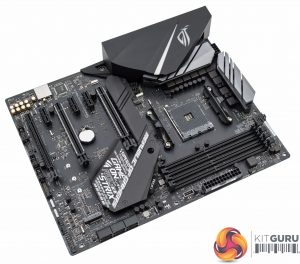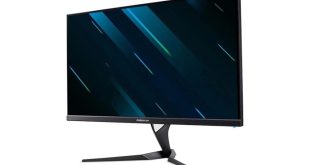The design of the ASUS ROG Strix X470-F Gaming is mostly subtle with a sleek black design though the “artistic” application of text on the heatsink and printed on the PCB may polarise consumers. The plastic shroud over the rear I/O area continues to be a recurring trend on ASUS ROG motherboards since it tidies up the overall aesthetic and allows for a more creative implementation of RGB LEDs filtered through the ROG logo.
On the subject of RGB LEDs there is just a single zone which illuminates the rear I/O plastic shroud. The LEDs sit underneath the shroud on a separate PCB and the illumination comes through as a diagonal strip and the ROG logo. This RGB area is fully configurable in the ASUS AURA software and supports a wide range of colours and lighting modes, including synchronisation with the optional RGB headers.
ASUS provides six SATA ports, the default complement of the chipset, as well as a USB 3.1 front panel connection which serves out the USB 3.1 bandwidth provided by the AMD X470 chipset. ASUS Q-LED diagnostic LEDs are on hand to assist with troubleshooting during the first build and any future overclocking endeavours.
Two RGB headers, 12V G R B and 5V digital, are located at the end of the motherboard along with a trio of two USB 2.0 and one USB 3.0 headers. The slower PCIe 3.0 X2 M.2 slot is also located in this section of the motherboard and supports only shorter 80mm drives.
Onboard audio is provided by the ASUS SupremeFX S1220A solution which is based on the Realtek ALC1220 codec. ASUS strengthens this implementation by using codec shielding, PCB isolation, two operational amplifiers (Texas Instruments RC4580 and OPA1688) and Nichicon audio capacitors.
The rear I/O is generously endowed with 8 USB ports spanning generations 2.0, 3.0 and 3.1 as well as Type-A and -C. Integrated display outputs are there for anyone opting for an AMD APU with integrated graphics.
The only notable omission is an onboard WiFi/Bluetooth module, though we're still not sure how popular these are on gaming desktops so this decision is likely a calculated omission by ASUS to reserve precious I/O space for other connectivity.
The CPU socket has immediate access to four fan headers which is ample for all CPU coolers. The third and final RGB header, type 12v G R B, is also located in the CPU socket area. There are two grey aluminium heatsinks on cooling duty for the CPU VRM components.
The primary M.2 slot, with 32Gbps of PCIe 3.0 x4 bandwidth, is located beneath a significant heatsink assembly. A quick dissection reveals this is formed of three constituent pieces, one for the PCH, one for the M.2 slot and then a third piece which links the two together.
This 3 piece solution is a little clunky to disassemble and install but since the user is unlikely to install an M.2 drive more than a few times it can be overlooked. Particularly given the strong cooling potential on offer, as will be demonstrated later on.
Underneath the motherboard is another glimpse at that polarising printed text on the motherboard PCB. Aside from a range of cross-head screws, which make for easy removal and maintenance, there isn't a lot else to see underneath.
The two aluminium heatsinks which provide cooling to the VRM are modest but appropriate for a motherboard of this positioning and should keep temperatures comfortable for daily overclocks providing there is reasonable ambient airflow.
There are higher-end cooling options available based on water-blocks and direct contact heat pipe designs but these are reserved for much more expensive motherboards.
The PWM controller is a custom-packaged ASUS unit marked ASP1405I which is likely an International Rectifier solution. KitGuru has seen this controller before on the ASUS ROG Maximus X Formula so it is likely a high-end unit.
The structure of the VRMs is not clearly specified by ASUS but appears to be a 6+4 phase solution (effective), though the PWM controller likely operates 6+2 phases and is probably an IR35201 in 6+2 phase mode.
The first six phases that supply the CPU voltage each have one choke and one IR3555M 60-amp integrated PowIRstage. This IR3555 unit integrates the driver, low- and high-side MOSFETs into a single package.
The next four phases which supply the SOC voltage are the same in terms of one choke and one IR3555 unit but also have two IR3599 phase doublers than turn two phases from the IR35201 controller into four phases for the motherboard's VRM.
This 6-phase solution for the CPU is robust for the upper mid-range and should perform better, in terms of temperatures and overclocking capability, than many less expensive X470 motherboards making use of 4-phase solutions.
The memory VRM makes use of a UPI Semiconductor uP8815p PWM controller and there are a number of ON Semiconductor MOSFETs (4C10B) as well as some chokes and other VRM components. It's likely to be a 1 or 2 phase solution but it is difficult to identify the structure exactly.
 KitGuru KitGuru.net – Tech News | Hardware News | Hardware Reviews | IOS | Mobile | Gaming | Graphics Cards
KitGuru KitGuru.net – Tech News | Hardware News | Hardware Reviews | IOS | Mobile | Gaming | Graphics Cards



















